Menu
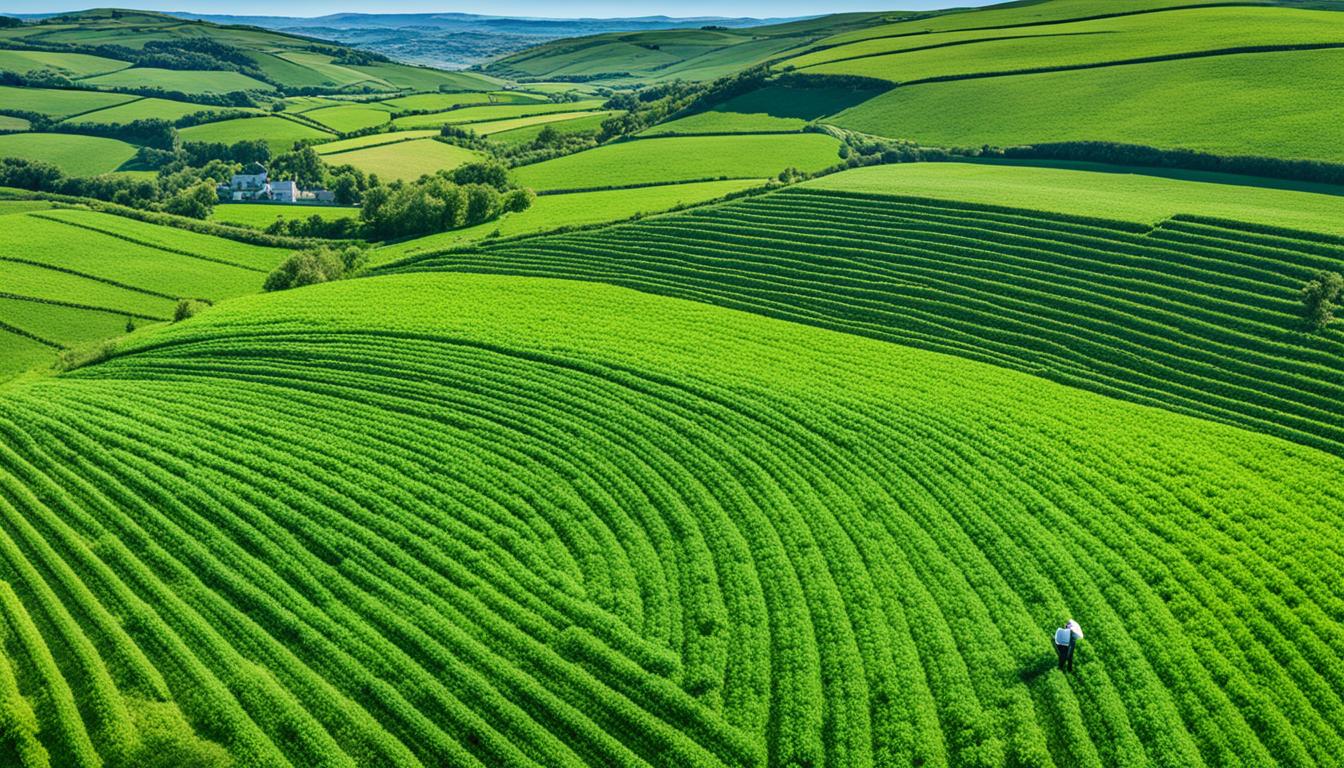
Ireland went over its limit for ammonia emissions seven times from 2010 to 2019. This is a big problem for farmers. The more animals and the more fertilisers they use, the worse it gets. In 2022, our farming made 38.5% of the nation’s greenhouse gases. Most of this came from cows making methane and from using fertilisers that create nitrous oxide. Even though emissions dropped slightly because we used less fertiliser, more cows were producing milk.
Farmers are now aiming to cut these harmful emissions. They’re looking at new ways to spread slurry and using better fertilisers. The main causes of our emissions are cow digestion, the ground on farms, and how we handle manure. To meet the new air quality rules, farmers have to change their ways. They need to keep up their work but also protect the environment.
Ireland works hard to keep the air clean by meeting tough EU air quality rules. It’s doing well, only going over the limits once since 2010. This success is a step towards reaching EU targets for cutting emissions by 2030.
To make the air better, Ireland focuses on reducing harmful gases from farming. These include gases like nitrogen dioxide, which can hurt our health. The EU says breathing polluted air is a big problem for people in cities, impacting health and work.
Producing more food while keeping emissions down is tough, yet Ireland’s farmers are committed. They follow strict EU climate goals and the UN’s Paris Agreement. This means Ireland’s farms are working hard to pollute less.
Ireland is also working towards reducing greenhouse gas emissions by 55% before 2030. It’s a big job that involves everyone. The goal is to use more renewable energy and cut down on using fossil fuels. This helps Europe become more independent when it comes to energy.
Ireland aims to meet tough air quality targets set by the WHO over the next few years. It’s focusing on making farming more sustainable. This helps in making the air cleaner, good for the planet and our health.
The EU and Ireland have agreed to take better care of nature. They aim for farms to work in a way that’s good for the environment. By doing this, they reduce harmful emissions from farming. It shows the important role farming in Ireland plays in protecting our planet.
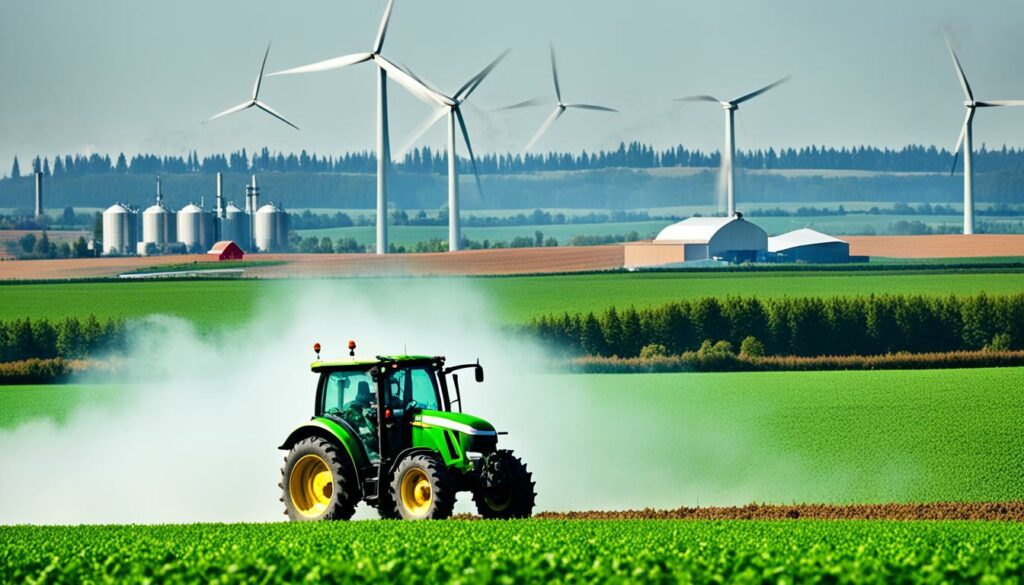
Air quality standards in Ireland greatly affect farming today. They focus on keeping the environment safe. But, they also push for changes in farming to protect the environment and keep it productive.
In 2022, agriculture in Ireland was a big part of the greenhouse gas problem, at 38.5%. Though emissions dropped slightly by 0.3% last year, they’ve gone up by 15.8% over the last ten years. This rise comes despite efforts. For example, there was more milk and dairy cow numbers increased. This shows there’s a tricky balance between making more and being eco-friendly.
Knowing where most emissions come from is crucial to control them. In 2022, gases from ruminants made up 62.44% of the total. Activities on agricultural soils were next, at 18.75%, with manure management third, at 11.66%. Energy from farming, forestry, and fishing added 3.94%. Liming and using urea fertilisers had smaller parts, at 2.67% and 0.54%.
Meeting air quality rules is tough for farmers in Ireland. They need to farm in a way that’s good for the environment and makes money. Some good news is that ways to cut emissions could lower them by 4% from 2021 to 2030. But, farming needs to grow, which makes cutting emissions harder. The hope is that by 2030, emissions will drop by almost 20% with new plans in place. This goal means farmers must keep finding new and better ways to farm.
Farmers in Ireland tackle big issues with some pollutants. Particulate matter, ammonia, and nitrogen dioxide are key challenges. They make farming with 4.76 million hectares tough, affecting 67.6% of Ireland’s land.
Particulate matter is bad for human health and farming. Fine dirt from machinery, animals, and fields harms health and crops. These are big issues for small-sized farms, which are common.
Livestock and their manure release lots of ammonia. Beef farming is a main source in Ireland. With most farms using land for feeding animals, cutting ammonia is key. Rules like the National Emission Ceilings Directive are very important. They aim to control ammonia, especially as more dairy cows are expected.
Nitrogen dioxide comes from fertilisers and machines. Bigger farms making over €100,000 a year should care more. They need to reduce nitrogen dioxide to protect the air and crops.
Ireland’s Clean Air Strategy is vital for dealing with these problems. It uses rules, good leadership, and watching closely. By working together, farmers can help achieve clean air. This is good for everyone’s health and the future of farming.
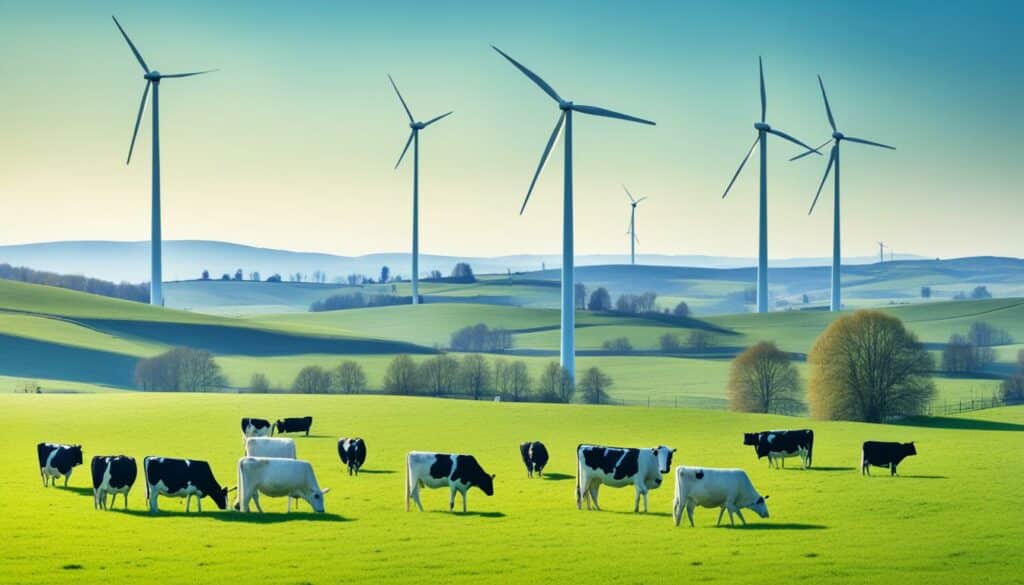
In Ireland, rules for looking after livestock are vital. They help keep farming productive while protecting nature. These rules focus on looking after the environment, making sure animals are treated well, and keeping our food safe. In particular, they help manage harmful gases like methane and ammonia.
Across the EU, 27 programmes in 15 countries are working to clean the air through agriculture. They’re part of the wider effort under the Common Agricultural Policy (CAP) 2023-27, which includes eco-friendly schemes. These efforts are clearly making a difference by improving the air and fighting climate change.
The laws guiding livestock farming are tough but necessary. They stand as a clear path, showing farmers ways to lower their farms’ impact on the environment. These laws also make sure farmers follow important rules set by the EU to protect nature.
~In 2022, farming in Ireland made up for 38.5% of all greenhouse gas emissions. But, there was a small drop in emissions that year, thanks to the hard work of both the government and the farmers. Together, they are moving towards farming that keeps our planet healthy.
Nitrogen fertilisers are key in growing crops in Ireland. But, they also cause harm by creating nitrous oxide gas. To lessen this, Ireland works on farming in ways that are good for the planet.
Synthetic fertilisers are a big part of why farming can harm the environment. In 2022, even though less of these were used compared to the previous year, nitrogen fertilisers still make up a large part of emissions. Ireland’s farms produced 38.5% of the country’s greenhouse gas emissions that year. As dairy cow and milk numbers grew, so did the farms’ impact on the environment.
Handling manure right is crucial for sustainable farming in Ireland. Bad manure practices release a lot of ammonia and methane, which harm the air. With nearly all ammonia from farms, it’s vital to manage manure well. The huge increase in sheep, pigs, and poultry over the last decade shows the need for this. Proper manure management not only cuts emissions but also meets environmental rules.
| Year | Animal Population Increase | Nitrogen Fertiliser Use Decrease | GHG Emissions Change |
|---|---|---|---|
| 2022 | 0.9% Dairy Cows | 14.0% | 0.3% Decrease |
| 2012-2022 | 42.5% Dairy Cows, 14.7% Sheep, 4.6% Pigs, 20.4% Poultry | – | 15.8% Increase |
| 2030 Projection | – | – | 4% Decrease under Existing Measures, 20% Decrease under Additional Measures |
In Ireland, it’s key to use sustainable farming methods to cut down on greenhouse gas emissions. These methods aim to make the air cleaner without harming farm output.
Reducing ammonia in the air is crucial. The LESS method decreases this gas from traditional slurry spreading. By adopting LESS, farmers can improve their environmental impact.
In 2022, manure management created 11.66% of the emissions from farming. This shows a big area where these changes could have a positive effect.
Using “stabilised urea” fertilisers is another smart approach. These fertilisers help crops soak up more nitrogen, cutting nitrous oxide emissions. Since 2021, there has been a 14.0% reduction in the use of nitrogen fertilisers, signifying a positive step forward.
Organic farming is gaining ground. It drastically reduces the use of chemicals. This means healthier soil and less harmful substances flowing into the environment.
Ireland aims to grow organic farming land five times. This growth will help the environment and support farming without harming the planet.
These farming methods tackle air quality issues and boost climate resilience for the long term. They show a smart way to do agriculture sustainably.
In the world of agriculture, new technologies are key to lowering emissions. They’re crucial because agriculture was the source of 38.5% of Ireland’s greenhouse gases in 2022. Thanks to advances in breeding, feed, and manure, the impact on the environment is improving.

Animal Breeding: A major way to reduce greenhouse gases is through breeding smarter livestock. Traits that lower emissions are being chosen. This effort has cut down methane, a big part of the pollution, by improving how much food each animal needs.
Feed Composition: Changing what animals eat is also helping. Scientists and farmers have created special food additives that cut methane during digestion. This not only reduces pollution but also keeps the animals healthier and more productive.
Manure Management: We’re also tackling emissions by handling animal waste better. Modern methods use devices called anaerobic digesters to turn waste into energy. This also cuts down on the harmful gases that come from manure. Thanks to better ways to handle and use manure, there’s been a drop in how much nitrogen is needed by farmers. This change has helped lower pollution by 14% since 2021.
All these steps are making Ireland a global leader in eco-friendly farming. They show a clear path towards cutting pollution, like the IPCC wants. By smart breeding, better food, and modern waste solutions, the farming industry is meeting its green goals.
Following the Ireland Air Quality Standards farming is key for farming’s future there. The rules in environmental regulations Ireland help Ireland meet EU goals. They also make the environment healthier.
Ireland is doing well (by 2022) to meet EU targets on emissions by 2030. This shows how important following strict air quality rules and using clean farming methods is.
From 2010, Ireland hasn’t gone over the EU limit for air quality except once. This shows their air cleaning actions work. Ireland aims to meet the WHO’s IT3 target by 2026.
The strategy has seven key areas for better air, including policy updates and more communication to share the plans.
The strategy aims to have better targets for air quality and make everyone more aware of clean air’s benefits. It includes better laws for less pollution and making government policies support cleaner air.
Farmers in Ireland are critical in this shared goal. They are using less fertiliser and better spreading methods. By doing so, they help achieve the air quality targets.
| Strategic Framework | Objective | Target Year |
|---|---|---|
| Policy Measures | Set appropriate targets for air quality improvement | 2026 (IT3), 2030 (IT4), 2040 (Final WHO values) |
| Governance | Integrate clean air considerations into government policies | Ongoing |
| Legislation | Enhance regulation for pollutant reduction | Ongoing |
| Enforcement | Ensure compliance with air quality standards | Ongoing |
| Monitoring | Continuous monitoring of air pollutants | Ongoing |
| Communications | Increase public awareness of clean air benefits | Ongoing |
In Ireland, farmers are making big changes to meet air quality rules. They are lowering emissions and using methods that keep the air clean. The dairy, sheep, and poultry industries are making important changes.
At dairy farms, they’re using new ways to spread slurry. Instead of on top of the soil, they either inject or spread it just under the surface. This helps reduce air pollution. They are also changing what they feed their animals to lessen harmful gases.
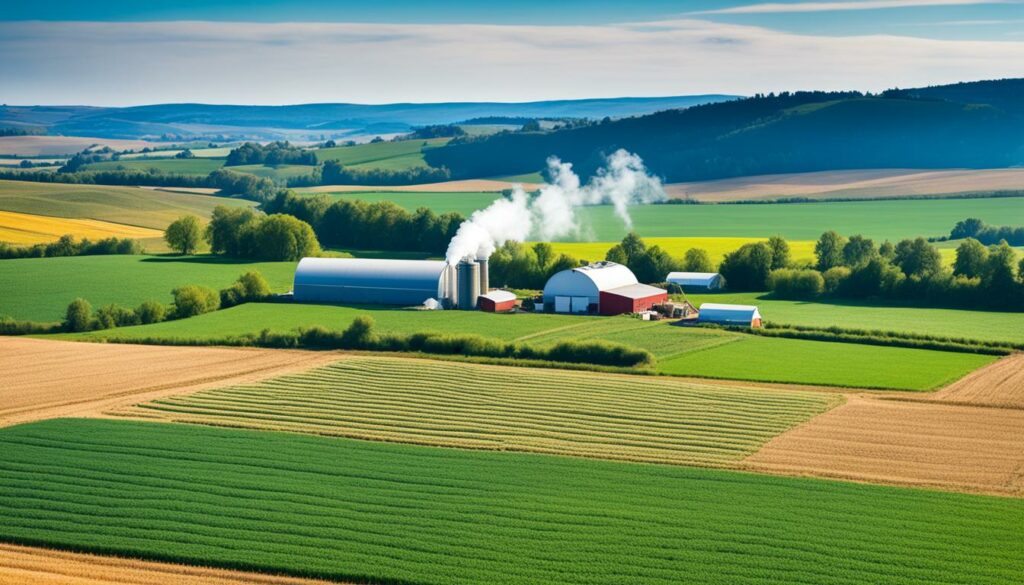
Sheep farming now uses a method where the sheep move to different fields. This helps the grass grow back and cuts down on harmful gas. It also makes the soil better. Poultry farms are also getting better by putting in special air filters to clean the air in the coops.
Both sheep and poultry farms are working hard to manage waste well. This is important for keeping the local area clean. These efforts show how serious Irish farms are about clean farming, which helps the environment a lot.
Irish farmers are meeting new environmental challenges head-on. They are finding ways to farm that are good for the earth and follow the rules. Their actions now will help keep farming sustainable for those who come after them.
In Ireland, the future looks promising for cutting agricultural emissions. The country aims to reduce its emissions by 20% from 2021 to 2030. This goal is set in the Climate Action Plan 2023.
The Environmental Protection Agency (EPA) in Ireland keeps track of greenhouse gas emissions. It looks at gases like carbon dioxide and methane. Their work is key for setting national policies and meeting international reporting standards.
New farming methods, like using special fertilisers, will help reduce emissions. These fertilisers lower the amount of harmful gases released into the air. This change shows the importance of new farming innovations.
| Emissions Sector | Projected Change (2021-2030) |
|---|---|
| Energy Industries | Decrease by 50-60% |
| Manufacturing Combustion | Decrease by 6-22% |
| Industrial Process | Increase by 5% |
| Agriculture | Decrease by 4-20% |
| Transport | Decrease by 1-35% |
| LULUCF | Increase |
| Residential | Decrease by 36-47% |
| Commercial and Public Services | Decrease by 19-49% |
Tracking land use and forestry changes is also crucial. These activities directly affect greenhouse gas levels. They follow strict reporting rules by the UN, showing emissions in ways people can easily understand.
Although things look up, there are still hurdles to jump. Ireland wants to be very low in greenhouse gas emissions. Yet, it might be tough to reach the big goal of reducing emissions by 51% by 2030.
Ireland’s plan is solid, focusing on greener farming. With these efforts, cutting down on harmful emissions seems doable. They are making bold steps towards a more nature-friendly agricultural sector.
The Irish government is committed to supporting sustainable farming. They help farmers shift to new methods without losing productivity.
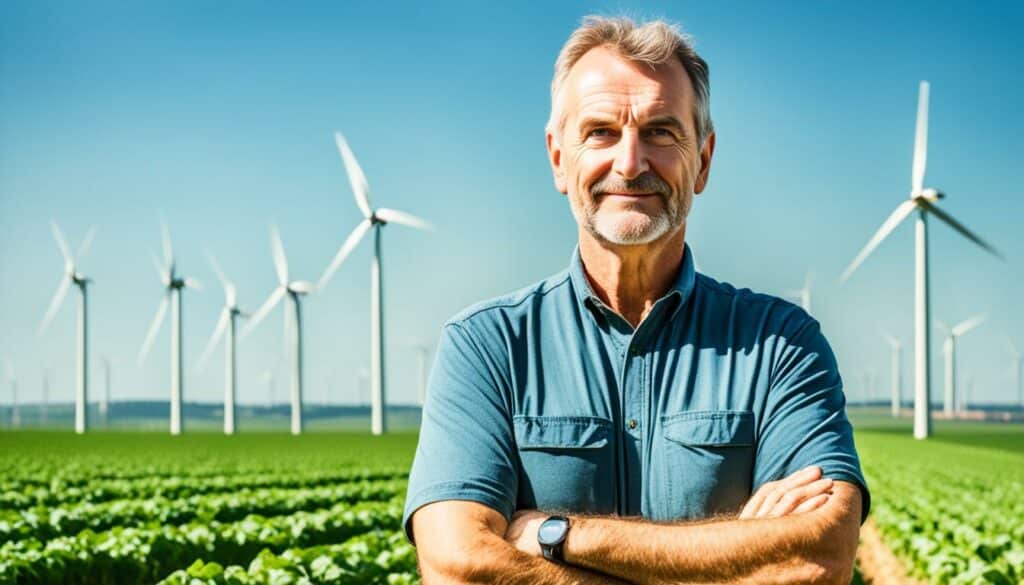
The Climate Action Plan 2023 works to cut greenhouse gas emissions from farming. It includes continuing the Basic Payment Scheme until 2024, with the same land rules and checks. This is a key part of helping government support funding farmers Ireland.
There are many funds to encourage sustainable farming in Ireland. The Farm Sustainability Transition Payment helps starting in 2025 for farms over 5 hectares. Also, the Beef Carbon Reduction Scheme pays farmers to lower beef emissions, starting at £20 per animal and climbing to £75. And, up to 352,000 cows can earn this. The Farming with Nature support is also open to those managing over 3 hectares of farmable land.
The government also focuses on educating farmers for sustainable farming in Ireland. They have special training to teach modern, green practices. Farmers must join the Farm Sustainability Standards and Soil Nutrient Health Scheme, which invests up to £45 million. It gets them ready for higher environmental standards.
Here is a brief on some key support schemes:
| Scheme | Details | Timeline |
|---|---|---|
| Basic Payment Scheme | Income support with land eligibility and cross-compliance | 2024 |
| Farm Sustainability Transition Payment | Supports environmental transition with a minimum 5 ha claim size | 2025 |
| Beef Carbon Reduction Scheme | Incentivises reduction in beef emissions, phased payments per animal | Starting January 2024 |
| Farming with Nature Package | Open to land managers with 3 ha+ of agricultural land | Ongoing |
| Soil Nutrient Health Scheme | £45 million investment to support soil health and sustainability | Ongoing |
Using the best pollution prevention methods in farming is key to reduce its effect on the environment. Farming in the EU causes most of the ammonia in the air. It’s crucial to manage nutrients and pick the right chemicals carefully. Methane from livestock also plays a big part in creating harmful ozone near the ground. So, it’s important to control how much gas animals release.
The EU is making good progress towards using less harmful chemicals in farming by 2030. But, it still faces a big challenge with ammonia levels in the air. Meeting the clean air targets from the World Health Organization will need continued hard work.
Cutting down on ammonia in the air is a good first step. Europe managed to lower its ammonia levels between 1990 and 2015. However, some places are seeing these levels go up again. By spreading manure in smarter ways and managing it better, farmers can help keep the air clean. This shows how farming can protect the environment and follow pollution rules better.
The Irish farming industry is at a key moment. Now, following rules and being green is a must, not a choice. The success of Ireland’s Air Quality Standards depends on farms using these rules every day. Farming makes nearly 10% of what Ireland sells abroad, about €14.5 billion in 2019. It also gives jobs to 173,000 people.
EU’s Farm to Fork Strategy and the European Green Deal help farms stay strong. They aim to make more food but not harm the planet. For instance, by 2025, Ireland wants to sell food worth 85% more, up to €19 billion. This plan also includes adding 23,000 new jobs.
Reaching these goals means everyone working in farming needs to be smart and use new ways. For example, using less-polluting methods to spread slurry and applying modern fertilisers. Both Ireland and the EU have rules to guide the way to a more eco-friendly farming future. Following these rules is key for long-term business success and keeping the environment healthy.
In the end, blending care for nature with making money will shape Irish farming’s future. By following Irish rules and getting help from the government, the farming industry can move ahead and protect Ireland’s beautiful lands. This action can inspire other countries too, showing how to mix old ways with new ideas for a green future.
Ireland’s Air Quality Standards follow EU limits for harmful pollutants. This affects farming by pushing for the cut of greenhouse gases. It means farmers must use methods that protect the environment without lowering productivity.
In 2022, agriculture made up 38.5% of Ireland’s greenhouse gas emissions. Livestock caused methane, and fertilisers created nitrous oxide. These gases came from livestock, using fertilisers, and managing manure.
Farmers worry about pollutants like particulate matter, ammonia, and nitrogen dioxide. Ammonia comes mainly from livestock and fertilisers. It’s a big issue because it often goes over safe levels.
The Irish government puts rules on livestock farming to protect the environment, animals, and food safety. It focuses on handling emissions and lessening nitrogen fertilisers. This helps control methane and ammonia.
Nitrogen fertilisers, especially synthetic ones, add a lot to nitrous oxide emissions. They boost crop growth but bring worries for the environment. Managing manure well is also key to cutting these emissions.
Ireland is turning to practices like Low Emission Slurry Spreading to cut down on air pollution. Farmers use “stabilised urea” for fertilising to lessen gases. They are also moving towards organic farming for fewer chemical needs.
Farming is getting more high-tech with better animal breeds, feeds, and manure ways. These steps help lower the farm’s carbon footprint. They are crucial for making Irish farming greener.
Dairy, sheep, and poultry farmers in Ireland are changing their ways to meet better air quality. The farming changes show how they can keep up production while protecting the air.
Ireland aims to cut farm emissions by 20% from 2021 to 2030. This ambition relies on new methods and government support. It’s part of the plan to fight climate change.
The Irish government offers help through the Climate Action Plan 2023. It provides money for green projects and gives lessons to farmers. These actions aim to make farming more sustainable.
To pollute less, farmers should use nutrients effectively, pick agrochemicals wisely, support conservation farming, and care about biodiversity. These steps help farming to be kinder to nature. They also meet Ireland’s Air Quality rules.